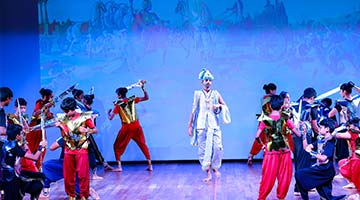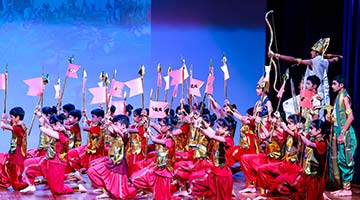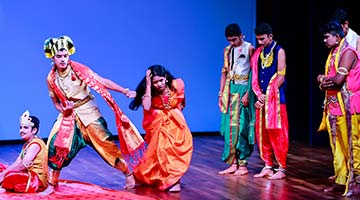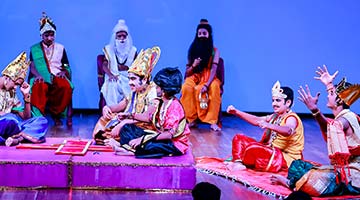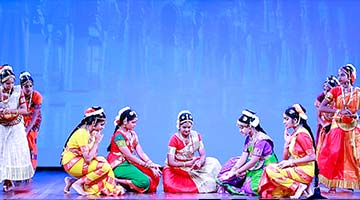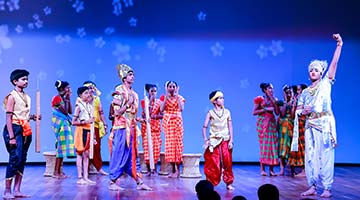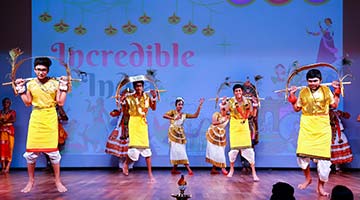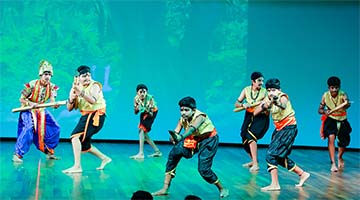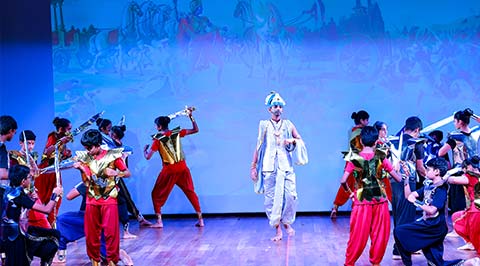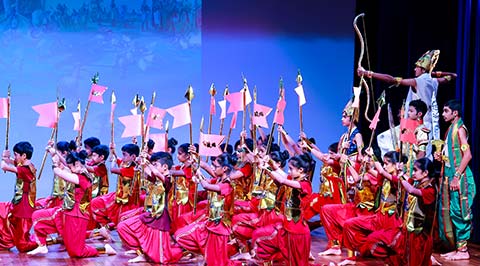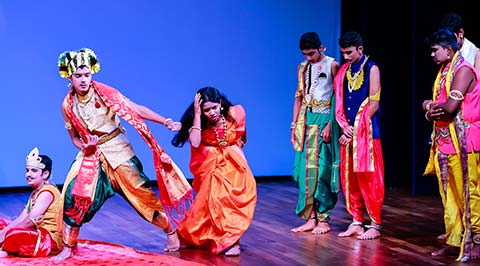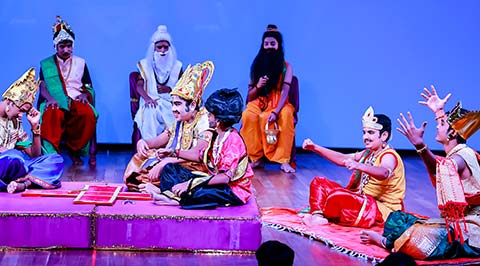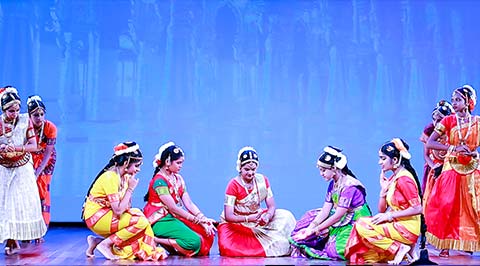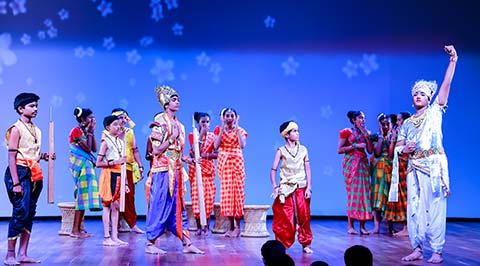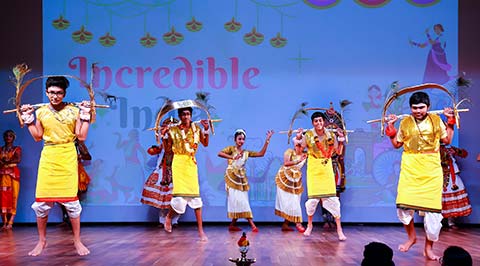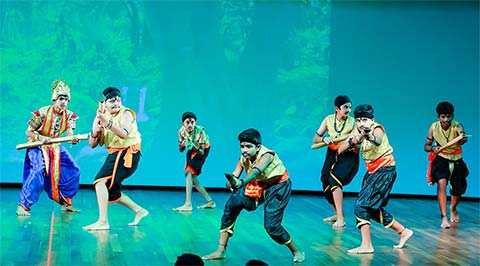“Utsaham”: Cultural Day
NPS International Chennai’s Annual Cultural Day, Utsaham 2022, was celebrated with pomp and splendour on Friday, 21st October. Students from Grades 6 to 9 presented their production “Mahaan Bharath - Mahabharath” to an enraptured audience.
The Chief Guest for the day was Ms. Radhe Jaggi, renowned Bharatanatyam exponent and the daughter of spiritual leader Sadhguru Jaggi Vasudev. Guests of honour included NPS Founder Chairman Dr K P Gopalkrishna, Dean Dr Santhamma Gopalkrishna and Chairperson Dr Bindu Hari. Also in attendance were NPS Administrator Mrs Lalitha Das, Principal of NPS Gopalapuram Mrs Sujatha Bokka, and Director of Global Montessori Centre Mrs Aparna Iyer.
It was a momentous occasion, marking the first Cultural Day Celebration to be held within the new School Auditorium. Over 400 students and 50 teachers were involved in the production of the 2-hour show. Presentations ranged from colourful tableaus to energetic dances, passionate acting to evocative narration. The entire show was presented before beautiful and perfectly synchronised backdrops, with well-timed lighting and music to set the stage.
The opening remarks were made by Principal of NPS International Chennai, Ms. Sudha Balan, with the Chief Guest Mrs. Jaggi and Chairperson Dr. Bindu offering their words of praise, encouragement and delight after the culmination of the program. The audience remained rapt and engaged, clapping enthusiastically after each performance and appreciating with laughs and gasps the various twists and turns in the story. Mrs. Jaggi spoke of the relevance of the Mahabharatha in today’s world and encouraged the students to follow their dreams. Dr. Bindu shared her appreciation for the scope of the project and added a note of kudos for the teachers. The programme was concluded with the National Anthem before the guests dispersed for the evening.
Parents and other guests were seated in the school auditorium by 3:00 PM, and the dignitaries made their entrance at 3:30 PM. The programme commenced with the ceremonial lamp lighting by the luminaries in attendance. This was followed by a traditional invocation to the Goddess Saraswati, performed on vocals, veena, flute, violin and mridangam by students themselves.
Principal Ms. Sudha Balan then presented the opening remarks. She welcomed the Chief Guest and other personages with tokens of appreciation, and spoke about the theme of this year’s Utsaham. She emphasised the hard work and dedication needed to put together such an immense undertaking, and shared words of recognition for teachers and students alike.
The programme began with the series of vignettes titled “Mahaan Bharat” presented by Grade 9. As the narrators catalogued the vast and rich culture of the nation, students appeared in the garb of significant scientific, cultural, and social touchstones. This section presented glimpses of all aspects of ancient Indian wisdom, knowledge and creativity - sculpture, architecture, painting, textiles and handicrafts, drama, poetry, music and dance. Students performed dances from all over the country, from classical dances like Kathakali, Bharatnatyam, Kathak, Kuchipudi, Odissi and Mohiniaataam; and folk dances like Kavadi Aattam, Mayil Aattam, Kol Aattam, Garbha and Bhangra. The audience was enraptured by each of the beautiful dance styles presented through their typical costumes and appropriate choreography.
The time then came for the presentation of the story of the Mahabharata itself. Before each scene, a brief narration explained the main stories chosen, and were beautifully brought to life by senior dancers on either end of the stage. The students then took the stage themselves to enact the various stories, interspersed with dances fitting each narrative. For many significant scenes, the singers performed shlokas from the epic, which further added to the atmosphere.
We began with a scene depicting the Sage Veda Vyasa dictating the epic to Lord Ganesha. This formed the backdrop to the story of King Shantanu of Hastinapura, who married first the Goddess Ganga and then the fisher princess Satyawati. The section was concluded with the story of Bheeshma, who renounced the throne for his father. A charming and energetic dance by the fisherfolk was well received by the audience.
The next section was a “Lineage Walk”. The line of kings and queens in the Kuru Clan were named and briefly described, and well-dressed and adorned students strode grandly across the stage in their royal robes. The Pandavas and Kauravas, the players in the war of the Mahabharata, were introduced. This scene concluded with the return of Queen Kunti with the five Pandava Princes to the kingdom of Hastinapura.
Several delightful forest scenes followed, showing the growing princes and their preceptor Drona, including the well-known tale of Ekalavya. The rivalry of the princes was further depicted through Duryodhana’s plot to poison his cousin Bhishma and drown him in the river. Featuring a grand feast and an energetic snake dance, this scene was very popular with the audience. The attempt on the Pandavas’ lives in the house of lac was accompanied by a fiery dance which captured the violence of the story.
After a brief interlude to follow the story of Lord Krishna, one of the major players in the Mahabharatha, the story picked back up at the swayamvara of Princess Draupadi. The classical tale of Arjuna, disguised as a Brahmin, wielding the mighty steel bow to win the hand of the maiden was depicted to excellent effect. The next major plot point was the establishment of the kingdom of Indraprastha, built with the help of Lord Krishna. Both these scenes featured beautiful and intricate Bharatanatyam dances to celebrate the occasions.
The dice game between the Pandavas and Kauravas was next to be depicted. The students ably enacted the emotions of glee, despair and rage as King Yudhistira gambled away everything he owned. The scene ended in darkness on the stage, while the narration announced the commencement of the Kurukshetra War.
The students of Grade 8, dressed in bright and contrasting military costumes and carrying the standards of the opposing armies, filled the stage and brought to life the passion, anger, violence and despair of the great war. The choreography was perfectly executed, and the stage was used to full effect. The stories of Krishna’s Vishwaroopam and the Bhagavad Gita, the defeat of Drona, the tragic loss of Abhimanyu, and the deaths of Karna and Bheeshma, were all depicted with a flawless combination of narration, action, music, lighting and background. The pin drop silence in the audience followed by rapturous applause after each story is a testament to the students’ performances.
The narrators brought the story to a close by describing the end of the war and its aftermath. They reiterated the significance of the great epic and its relevance in today’s world. The dancers then performed a traditional “mangalam” to end the programme.
